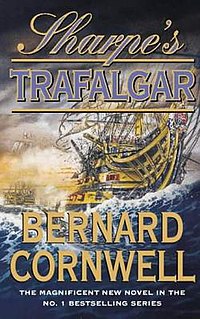 W
WThe Battle of Trafalgar was a naval engagement fought by the British Royal Navy against the combined fleets of the French and Spanish Navies during the War of the Third Coalition of the Napoleonic Wars (1803–1815).
 W
WThe Battle of Trafalgar, 21 October 1805 is an 1822 painting by British artist J. M. W. Turner. It was commissioned by King George IV as a part of a series of works to decorate three state reception rooms in St James's Palace and link the Hanoverian dynasty with military success. This work was Turner's only royal commission, and was to stand as the pendant piece to Philippe-Jacques de Loutherbourg's Lord Howe's action, or the Glorious First of June. This massive history painting measures 2,615 millimetres x 3,685 millimetres and was given to Greenwich Hospital shortly after its original installation. The painting now hangs in the National Maritime Museum, also in Greenwich, London.
 W
WThe Collingwood Monument is a Grade II* listed monument in Tynemouth, England, dedicated to Vice Admiral Lord Cuthbert Collingwood. A Napoleonic-era admiral noted for being second-in-command to Admiral Lord Nelson during the Battle of Trafalgar, Collingwood is sometimes referred to as the forgotten hero of Trafalgar. The monument's base is by John Dobson and the statue is a work of the sculptor John Graham Lough. It is situated just off of Front Street in Tynemouth and overlooks the mouth of the River Tyne.
 W
W"England expects that every man will do his duty" was a signal sent by Vice-Admiral of the Royal Navy Horatio Nelson, 1st Viscount Nelson from his flagship HMS Victory as the Battle of Trafalgar was about to commence on 21 October 1805. Trafalgar was a decisive naval engagement of the Napoleonic Wars. It gave the United Kingdom control of the seas, removing all possibility of a French invasion and conquest of Britain. Although there was much confusion surrounding the wording of the signal in the aftermath of the battle, the significance of the victory and Nelson's death during the battle led to the phrase becoming embedded in the English psyche, and it has been regularly quoted, paraphrased and referenced up to the modern day.
 W
WMary Buick was a Scottish nurse who was working aboard Vice-Admiral Nelson’s HMS Victory when he died in The Battle of Trafalgar. She tended to Nelson's body and prepared it for its journey home.
 W
WPedro Sáinz de Baranda y Borreiro was a Naval Officer, Industrialist and Liberal Politician who served in the Spanish Navy and, having participated in the Mexican War of Independence, is credited with founding the Mexican Navy. During 1835, he served on two occasions as Governor of Yucatán. As an entrepreneur, he founded the first completely mechanized textile factory to use steam-power successfully in Mexico; he is widely regarded as having introduced the Industrial Revolution to the country.
 W
WSharpe's Trafalgar is the fourth historical novel in the Richard Sharpe series by Bernard Cornwell, first published in 2000. It is the first of the novels in the wars against Napoleon, putting the army ensign at the Battle of Trafalgar in 1805. The novel is the first time that Sharpe encounters the Nock Gun, originally developed for the Navy and the later weapon of choice of Patrick Harper.
 W
WThe Order of battle at the Battle of Trafalgar is a presentation of data such as is known concerning the commanders and the ships that shaped the Battle of Trafalgar on 21 October 1805. Included are tabular presentations of the fleets that participated in the battle, the order in which they sailed and attacked, and a graph of the percentage of casualties plotted for each ship along the three battle columns.
 W
WTrafalgar Square is a public square in the City of Westminster, Central London, established in the early 19th century around the area formerly known as Charing Cross. The Square's name commemorates the Battle of Trafalgar, the British naval victory in the Napoleonic Wars over France and Spain that took place on 21 October 1805 off the coast of Cape Trafalgar.